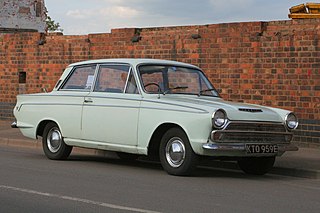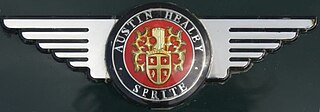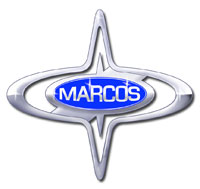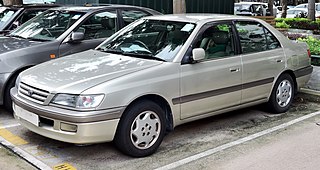
The Ford Cortina is a medium-sized family car that was built initially by Ford of Britain, and then Ford of Europe in various guises from 1962 to 1982, and was the United Kingdom's best-selling car of the 1970s.

The Austin-Healey Sprite is a small open sports car produced in the United Kingdom from 1958 until 1971. The Sprite was announced to the press in Monte Carlo by the British Motor Corporation on 20 May 1958, two days after that year's Monaco Grand Prix. It was intended to be a low-cost model that "a chap could keep in his bike shed", yet be the successor to the sporting versions of the pre-war Austin Seven. The Sprite was designed by the Donald Healey Motor Company, with production being undertaken at the MG factory at Abingdon. It first went on sale at a price of £669, using a tuned version of the Austin A-Series engine and as many other components from existing cars as possible to keep costs down.

Marcos Engineering was a British sports car manufacturer. The name derives from the surnames of founders Jem Marsh and Frank Costin.

The Toyota Corona is an automobile manufactured by the Japanese automaker Toyota across eleven generations between 1957 and 2001. On launch, the Corona was Toyota's next to highest product in their range, just below the Crown. The Corona was marketed in the JDM at Toyota's Toyopet Store dealership channels, and the Corona was one of Toyota's first models exported to other global markets, followed by the smaller Toyota Corolla.

The Triumph Spitfire is a British front-engined, rear-wheel drive, two-passenger convertible sports car introduced at the London Motor Show in 1962 and manufactured between 1962-1980. Styled for Standard-Triumph in 1957 by Italian designer Giovanni Michelotti, the Spitfire was manufactured for the duration of its production at the Standard-Triumph Canley works — and evolved over a series of five production iterations, with approximately 315,000 manufactured over 18 years.

The Triumph GT6 is a 6-cylinder sports coupé built by Standard-Triumph, based on their popular Triumph Spitfire convertible. Production ran from 1966 to 1973.

The Triumph Vitesse is a compact six-cylinder car built by Standard-Triumph from May 1962 - July 1971. The car was styled by Giovanni Michelotti, and was available in saloon and convertible variants.

The MGB is a two-door sports car manufactured and marketed from 1962 until 1980 by the British Motor Corporation (BMC), later the Austin-Morris division of British Leyland, as a four-cylinder, soft-top sports car. It was announced and its details first published on 19 September 1962. Variants include the MGB GT three-door 2+2 coupé (1965–1980), the six-cylinder sports car and coupé MGC (1967–69), and the eight-cylinder 2+2 coupé, the MGB GT V8 (1973–76).
The Austin Cambridge is a motor car range produced by the Austin Motor Company, in several generations, from September 1954 through to 1971 as cars and to 1973 as light commercials. It replaced the A40 Somerset and was entirely new, with modern unibody construction. The range had two basic body styles with the A40, A50, and early A55 using a traditional rounded shape and later A55 Mark IIs and A60s using Pininfarina styling.

The Humber Super Snipe is a car which was produced from 1938 to 1967 by British-based Humber Limited.

Elva was a sports and racing car manufacturing company based in Bexhill, then Hastings and Rye, East Sussex, United Kingdom. The company was founded in 1955 by Frank G. Nichols. The name comes from the French phrase elle va.

Albion Motors was a Scottish automobile and commercial vehicle manufacturer.

Fairthorpe cars were made in Chalfont St Peter, Buckinghamshire, England between 1954 and 1961, from 1961 to 1973 in Denham, Buckinghamshire.

Ginetta Cars Limited is a British specialist builder of racing and sports cars based in Garforth, Leeds, West Yorkshire.

Rochdale cars were a series of mainly glass fibre bodied British sports car made by Rochdale Motor Panels and Engineering in Rochdale, Greater Manchester, England between 1948 and 1973. The company is best remembered for the Olympic coupé made between 1959 and 1973.

The Unipower GT is a British specialist sports car that debuted at the January 1966 Racing Car Show. It uses the powertrain from the BMC Mini mounted amidships. Production lasted until the end of 1969.

The TVR Grantura is the first production model in a long line of TVR cars. It debuted in 1958 and went through a series of developments leading to the Mark I to Mark IV and 1800S models. The last ones were made in September 1967.
Sylva Autokits is a kit car manufacturer based in Lincolnshire, England. Sylva was founded in 1981 by Jeremy Phillips and has developed and produced a number of small and lightweight sports cars. Sylva cars have won a number of 750 Motor Club Kit Car championships.

The Bond Equipe is an English 2+2 sports car, manufactured by Bond Cars Ltd from 1963 to 1970. It was the first 4-wheeled vehicle from Bond Cars.

The Marcos GT is the name used by the British firm of Marcos Engineering Ltd for all of their cars until the introduction of the Mantis in 1970. Most commonly, the name is used to describe the very low coupé designed by brothers Dennis and Peter Adams.


























